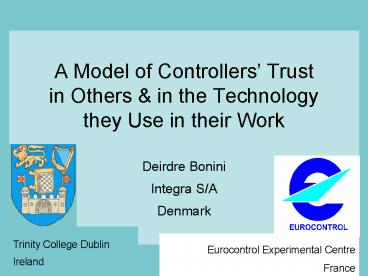A Model of Controllers - PowerPoint PPT Presentation
1 / 17
Title: A Model of Controllers
1
A Model of Controllers Trust in Others in
the Technology they Use in their Work
2
Presentation
- Definition of trust
- Trust in Air Traffic Control
- Model of trust
- Hypotheses
- Method
- Results
- Conclusion
3
A Definition of Trust
- Trust is
- A choice a trustor makes to give the trustee
control (e.g. delegate task) - Based on a belief that the trustee will carry out
an action / behave in a certain way - With the view of a positive outcome for the
trustor
4
Trust in Air Traffic Control
- Why is trust relevant to Air Traffic Control?
- A precursor of cooperation (Deutsch, 1958 Baier,
1986 Muir, 1989 Kramer, 2001) - The work of a controller can be seen as a
collaboration with colleagues, with pilots
through technology, and with technology by using
the information it provides - Due to the trend towards controller mobility
(standardisation of training) introduction of
technology it is increasingly important to
understand how to optimise team work the use of
technology
5
Model of Trust
- Developed from
- Literature review
- Observation of controllers at work
- Three Questionnaires
- Focus groups
- One-to-one interviews
- Three elements
- Self
- Belief
- Control
6
Self
- Self confidence
- Confidence in ones ability to judge others
situation - Outlook on the world (i.e. trusting in general or
not) both towards others (Zand, 1972) and towards
technology (Lee Moray,1994)
7
Belief
- Cognitive frameworks used to interpret a
situation anticipate events (e.g. mental
models, schemas) - Literature controllers consider competence as
relevant in trust decision - Rulers/scales to describe competent controllers
technology
8
Competence Ruler
- Rulers for French, Irish, Italian controllers
(competent others technology) - Example of Italian technology competence ruler
Lowest Highest
0 36 38 53 61 66
Fast Gain time Of help Simple to use Useful Clear Display
9
Control
- Implicit/explicit rules define, mediate
constrain trustor trustee co-operation - Roles (e.g. an actors role defines their
behaviour social interactions) contracts - Choice (need to understand context)
10
Null Hypotheses
- Self
- No difference between low/high self confidence
- No difference (both for others technology)
between low/high trustors - Belief
- No difference between low/high competence (for
both others technology) - Control
- Cultural differences will be found in trusting
behaviour (for both others technology)
11
Method
- Scenario-based questionnaires
- Ten scenarios
- Questionnaires Incident reports Support of 5
operational experts - Iterative process (both analytical empirical
approach) - Operationally sound Not specific to one
operational environment Not a test with a
right/wrong answer
12
Participants Design
- Irish (26)
- 11 control
- 15 experimental condition
- Italian (44)
- 16 control
- 28 experimental condition
- Volunteers in 4 control centres
Controller Technology
Sc1 HIGHER HIGHER
Sc2 LOWER LOWER
Sc3 LOWER HIGHER
Sc4 HIGHER -
Sc5 HIGHER LOWER
Sc6 - HIGHER
Sc7 LOWER -
Sc8 - LOWER
Sc9 LOWER -
Sc10 - LOWER
13
Results Self
- All respondents rated themselves high on
self-confidence - Towards others most respondents rated high
(69-86) - Towards technology Italians low (57) Irish
high (58) - No significant correlation between attitudes
trust decision
14
Results Belief
- Participants under control exp. condition chose
same answer (trust or no trust) - Both lower higher characteristics were positive
- Narratives maybe not neutral?
- Significant correlation between competence
trustworthiness ratings
15
Results Control
- Italian Irish responded differently to 3
scenarios, but no significant difference found - what would change your answer?
- Individual differences or cultural differences?
16
Conclusions
- No conclusive validation
- Should test model components separately (Belief
component more than competence) - Need to separate effect of culture versus
individual differences (self, belief, control) - Consider the interaction between controller
technology competence effect on trust - Relation between ratings of competence
trustworthiness (both others technology) - Scenarios found to be effective way to interact
with controllers - Perhaps follow-up with interview
17
Questions ?































